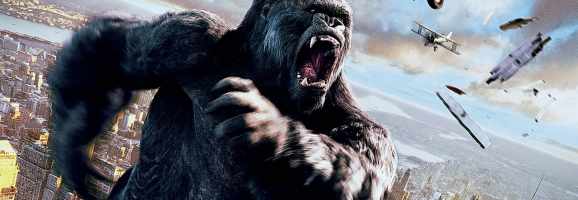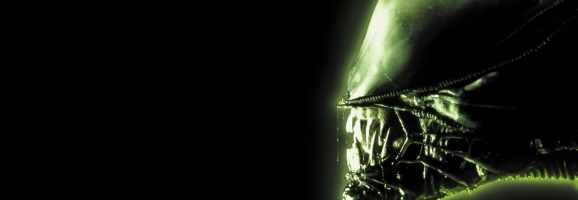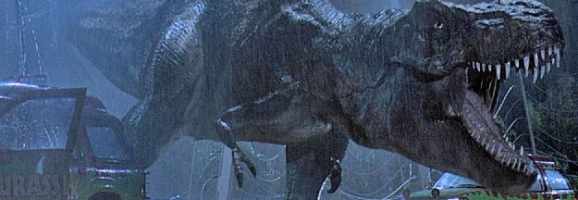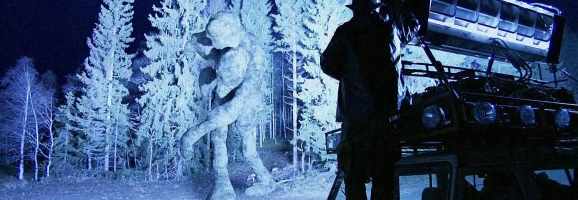The Monsters of Cinema: Aliens, Apes and Abominations
Guillermo del Toro is no stranger to monsters. His first feature-film, Cronos, is a harrowing parable of addiction in the form of vampirism. His Spanish-language films, the Devil’s Backbone and Pan’s Labyrinth, are beautifully twisted fairy tales packed with a host of monstrosities. His anti-hero, Hellboy, faces an onslaught of creatures and creepers in the eponymous comic-book adaption. His latest endeavor pits the human race against giant aliens in a grudge match set to total the entire planet. As the buzz becomes deafening, we take you on an exploration of the most gruesome enemies mankind has ever faced …
5. Not Everything is Black and White (1922-1935)

One of the earliest forms of the monster-horror villain is the German Expressionist piece, Nosferatu (1922). The film reworks the classic Bram Stoker novel, Dracula, in formidable fashion with Max Schrek donning the cape and fangs as the Count himself. The influence has been profound, spawning countless spin-offs and re-imaginings. Joel Schumacher’s 1987 cult-classic, the Lost Boys, saw Kiefer Sutherland and Jason Patrick sink their teeth into the vampire’s place in pop culture. Five years later, Francis Ford Coppola’s Dracula followed the source material closely, featuring Gary Oldman in a criminally underrated lead role (and as the historical inspiration, Vlad the Impaler) and Sir Anthony Hopkins as an extraneous Van Helsing.
However the golden-age had more to offer than just bats and blood-suckers. The 1930’s saw Boris Karloff as the animated collection of spare parts in Frankenstein (1931), again in the sequel Bride of Frankenstein (1935), and as the equally iconic Egyptian corpse in the Mummy (1934). Though both creatures had considerable influence on future antagonists (anybody remember de Niro’s turn as the Monster in Kenneth Branagh’s 1994 Frankenstein?), reincarnations have proved to be less memorable than the beloved originals.
4. The Eighth Wonder of the World (1933-2005)

Perhaps the most well-known monster to grace our screens, the RKO-produced King Kong (1933) is a product of its times. The film details one ship’s perilous journey to an uncharted island in an attempt to finish a film … before coming face-to-face with the indigenous natives and their bane, a mighty gorilla known as Kong. Fay Wray plays Robert Armstrong’s leading lady and Bruce Cabot plays the hero, John Driscoll.
Yet despite their seemingly heroic endeavors, to delve deeper into the mythos and thinking behind Kong is to uncover subjective and discriminate undertones. It is common belief among film critics that the picture reflects an ignorant fear of colonization in America. It is argued that Kong represents the African slaves brought from their continent to the Land of Opportunity, and his rampage through New York City mirrors the fears that the African-American people would cause havoc and chaos. Unsubtly, before the climax of the film, two theatre patrons discuss Kong. One says to the other that the show is about a big gorilla while the other retorts, ‘ain’t we got enough of them in New York?’
The zeitgeist of the time is evident in these few words alone, yet has done little to quell Kong’s box-office fame. Most notably, King Kong appeared in Peter Jackson’s 2005 epic, utilizing Weta’s motion-capture technology to bring the ape to life. Andy Serkis delivered a much more human Kong than the original, and while the film is criticized for being self-indulgent and bloated, it still provides the definitive depiction of cinema’s most notorious ape.
Audiences have seen him battle dinosaurs and level Manhattan. Adrien Brody, Jeff Bridges and even Jack Black were powerless to stop the almighty beast. But it is in Japanese pop culture where King Kong lies closest to del Toro’s Pacific Rim.
Over the years, Tokyo has been destroyed by giant sea monsters and has played host to an epic showdown between the giant gorilla and another fearsome foe of gargantuan proportions. Godzilla. The 90s blockbuster was a critical disaster, but the image of the radioactive abomination destroying skyscrapers is legendary. One look at the Pacific Rim trailer, showing huge creatures rise from the sea to destroy humanity, and you can see the Japanese monster genre’s inspiration. With the lizard’s previous outing being such a bland disappointment, one cannot help but feel apprehensive at the latest dive into the concept – even more so for the upcoming Godzilla reboot.
3. Isolation and Space: Monsters from Another World (1979-1986)

Ridley Scott created it. James Cameron multiplied it… and they should have left it there.
Quite simply, there has been no horror villain as unique or terrifying as the Xenomorph in Alien (1979) and Aliens (1986). H.R Giger’s creature design is the stuff of nightmares. From the face-hugger latching onto John Hurt, to the snake-like beast that bursts from his chest cavity, Alien continues to shock audiences across the globe – thirty years after its initial release.
Further installments proved to be stale, though Prometheus was an entertaining exploration into the universe and lore of the Xenomorph. Nevertheless, the vision of Ridley Scott paved the way for other science-fiction/horror filmmakers to try their hand in the genre.
Take John Carpenter’s, the Thing (1982), for example. Adapted from the Thing from Another World, it bares striking similarities with Scott’s Alien.
- Both films isolate their characters. Alien pits Sigourney Weaver against the Xenomorph aboard a mining ship and the Thing leaves Kurt Russel and Keith David stranded in the South Pole.
- The flamethrower proves to be the weapon of choice for both parties.
The effects and make-up were groundbreaking for the time, though a little dated now. The scene in the dog kennel in particular comes to mind. Like Alien, the Thing slowly increases the tension over the first half of the film until it finally snaps in your face, grabs your throat and launches you into the cage with the terrified dogs, not letting you out until the facility has been burnt to the ground.
With these two sci-fi heavy-hitters ushering in the new decade, they proved that a truly original idea could maintain the same staying power as the better-known movie monsters, leaving a lasting imprint for generations to come.
2. The Nineties and Beyond: The Giant Footprints in the Sand (1993-2014)

In the 1970s, Steven Spielberg successfully scared the beach resort business into redundancy with Jaws. The giant shark stalking the waters of a small coastal town not only defined Spielberg as cinematic royalty, but also saw a revival in quality monster movies. He didn’t even need to show the fish for most of the film. Just a fin slicing through the waves; a pool of blood and punctured inflatable washing onto the shore.
The man’s return to the genre is legendary.
Sam Neill, Laura Dern, Jeff Goldblum and Sir Richard Attenborough. Hardly crowd-pulling A-listers, though their talent is unprecedented. A Tyrannosaurus Rex brought back from extinction? Eating Martin Ferrero on the toilet? Box-office gold!
Jurassic Park was the most incredulous blockbuster of the nineties. The CGI was astounding (though not gratuitous, hand-built models were used whenever possible), unlike anything audiences had seen before. Based on Michael Crichton’s science-fiction novel, the film concerns a newly-built theme park filled with dinosaur clones. All is well … for the first half an hour. Then the dinosaurs escape and all hell breaks loose. John Williams’s score soars and rumbles with the tone of the film, providing the magic and emotion of the touching scenes, and the epic suspense whenever the T-Rex or Velociraptors appeared.
The film was not only the sole cause for a mass rejuvenation in the prehistoric, but also the crowing jewel in the monster genre, showcasing the sheer power of modern-day special effects in bringing gargantuan beasts to life – something that was not witnessed again until Peter Jackson’s King Kong. Though the two sequels fell short of the very high bar set by Jurassic Park, the interest in the franchise is still very much alive, with social networks and the ‘blogosphere’ rife with rumors and talk of the latest installment.
1. The Modern Monster Movie (2006 – )

What lies in store for the monster genre? The 21st Century has given viewers a mixed bag in what it has to offer. The found-footage genre has been punching above its weight with Cloverfield (2008) and Troll Hunter (2010). Like Jurassic Park and Alien, Troll Hunter committed itself to something wholly original (a man hunting giant trolls in the Scandinavian wilderness is original right?) while giving occasional nods to folklore, namely the tale of the three goats on the bridge. The 2006 film, the Host, was another that surprised. Featuring a giant sea monster terrorizing the Korean peninsular, it resides as one of the better genre offerings in the past twenty years.
That being said, decent monster movies have been few and far between. Take one look at the Alien franchise and you will see a significant dip in quality. Arnie’s Predator was a fresh and original action film, but its sequels (and the Alien v Predator spin-off) lacked the spark that ignited their predecessor. Vampires and werewolves had a stake firmly plunged through their heart in the form of the Twilight saga … but of course, you already knew that.
Pacific Rim is being touted as a film that needs to be ‘experienced’. A recent trip to see Star Trek: Into Darkness in IMAX gave a snippet of what the experience will feel like on the big screen. The two-minute advert well and truly wets the viewer’s appetite. It seems that Guillermo del Toro, the visionary that he is, holds the fate of the genre in his hands. He has delivered time and time again, creating innovative creatures and breathing new life into old favorites. Will he do it again on July 12?
What do you think? Leave a comment.











Pacific Rim does look good, but there is something lacking in terms of movie monsters. Great article.
I think people are walking a tight line when it comes to making monster movies. It seems that you have to rely on over the top CGI or play it low-key and increase the atmosphere, the former hardly ever works but I have high-hopes that Pacific Rim can be a over the top and a genuinely good film
Nice post. I have been planning to name my son Nosferatu – think about it! He will be popular!
No really, you can rely on Toro, he has not failed us before and we will not do it this time. I bet everything on it.
One of the highlights of Hellboy 2 was the big showdown with the giant plant thing in the city, I’m looking forward to something similar on a bigger scale.
And Nosferatu is an amazing name!
Nice article!
I think I am the only person alive that actually likes Alien 3. Particularly the Director’s cut. All 4 (or 5 if you count Prometheus) films feel like they are from different franchises to me, but all have something good in them.
I am also one of the few who has no interest in a new Jurassic Park film (number 4 was recently shelved again)and I wished they had stopped with the first.
I will have to give Pacific Rim a try, the trailer just didn’t grab me though.
I grit my teeth and try to force myself to like Alien 3 because it’s Fincher but I don’t feel its in the same class as the first two. And I’m apprehensive with the new Jurassic Park but I hold the first in such high regard that I’m holding out for a return to glory.
Well written,and strongly voiced. I really enjoyed the article, and will definitely give a couple of the recommended films a watch (especially Troll Hunter).
Thank you Jay, definitely give Troll Hunter a go, it really surprised me when I first watched it!
Very interesting article! It will be interesting to see more of del Toro’s monster homages in Pacific Rim, the trailers would suggest he’s nailed it again.
As I said in the article, the trailer in IMAX was enough to convince me that this is a must-see in the format at least
Pacific Rim looks like it is balancing carefully on the tight-rope between the monster fan niche and the mass market appeal of something like Transformers. I just hope it doesn’t veer too far towards Bayhem.
I think a lot of people will be comparing this to Transformers and Battleship, I anticipate that the public praise will be high, and that Guillermo will be faithful to his following and his inspirations for this movie. Critics on the other hand, that’s another matter …
As long as it makes money, there’s nothing the critics can do.
Money means sequels. Sequels means more del Toro (hopefully). I always wondered what his version of the Hobbit would have been like as well.
Well I’d like to think that GDT would’ve stayed away from turning it into nine hours of turgid dullness. One 2-3 hour movie is all he would need.
When I started this article I was concerned that you would miss an important monster genre, but no worries. Great job. I’m looking forward to some good stuff from you in the future, Barham.
What were you worried I’d miss? Thanks for the support J. I tried to include Gremlins in the article, but seeing as though this is anticipatory of Pacific Rim, I couldn’t fit them in anywhere.
Thank you for reading and commenting!
Fabulous article! I love how you write, you make me want to go and watch every film you mention, especially Gary Oldman as Dracula, have to go watch that now! Excited for pacific rim, especially after reading this!
Good, because we’re going in IMAX to see it! Thanks for reading babe, I love you!
Great article – thoroughly enjoyable overview of the monster sub genre! I’m a big fan of del Toro – he has always had a strong penchant for monsters, ghosts and ghouls, carefully balancing style with substance, so I have high hopes for Pacific Rim. Obviously it will have a greater blockbuster-spectacle sensibility in comparison to his previous works (even Hellboy), but hopefully his love for monsters will not have been lost in such a big studio budget!
Thank you for the reply and kind words Sophie. There was a fantastic piece by del Toro in this month’s Empire magazine. His love for the kaiju genre really came across and his direction and vision for the film, from what he says, sounds top notch!
He’s a fantastic director though, I even enjoyed Mimic to some degree, and I’ll never forget the first time I saw Pan’s Labyrinth, what an incredibly made film that is!
Keep up the good work and thanks again for commenting!
Clover field is one of those films that had a lot of hype going in but ended up being largely forgotten, or so it seems.